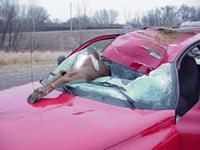Tiz the Season for Stupid Deer Tricks, $1.5 Billion Worth - Be Careful Out There
 |
Editors Note: Last week my 18 year old daughter had a deer jump in front of her car as she drove to school...needless to say the car was severely damaged and although she is ok physically, mentally she is hurt, she was lucky...Be careful out there.
MANY DEATHS IN VEHICLE-ANIMAL COLLISIONS ARE AVOIDABLE MAJOR FACTOR IS FAILURE TO USE SAFETY BELTS AND MOTORCYCLE HELMETS; FATAL CRASHES JUMPED 27 PERCENT IN 2003 COMPARED WITH PREVIOUS YEAR
ARLINGTON, VA -- Most of the motor vehicle crash deaths in collisions with animals such as deer occur in subsequent events when a vehicle runs off the road or a motorcyclist falls off the bike. Many of these deaths wouldn't occur with appropriate protection. In a new study of the characteristics of fatal vehicle-animal crashes, the Insurance Institute for Highway Safety found that 60 percent of the people killed riding in vehicles weren't using safety belts, and 65 percent of those killed riding on motorcycles weren't wearing helmets.
"A majority of the people killed in these crashes weren't killed by contact with the animal," says Allan Williams, the Institute's chief scientist. "As in other kinds of crashes, safety belts and motorcycle helmets could have prevented many of the deaths."
Fatal crashes involving animals have increased since the mid-1990s, federal government data show. During 1998-2002, the annual average was 155 crashes in which vehicle occupants died. This compares with an average of 119 fatal crashes during 1993-97. In 2003 there were 201 fatal crashes, a 27 percent increase compared with 2002.
The Institute examined 147 police reports on vehicle-animal collisions in which there was a human fatality. These deaths occurred in nine states representing different regions of the country (Colorado, Georgia, Minnesota, Missouri, North Carolina, Ohio, Pennsylvania, South Carolina, and Wisconsin). The reports account for 32 percent of the fatal vehicle-animal crashes in the United States during 2000-02. Passenger vehicles were most frequently involved. They accounted for more than half of the crashes. However, motorcycles were the striking vehicles in more than one-third of the cases, even though registered cars, SUVs, and pickups outnumber motorcycles on the road by about 40 to 1. Most collisions involve one vehicle only: Eighty percent of the vehicle-animal collisions involved a single passenger vehicle, motorcycle, truck, all-terrain vehicle, or moped. In 38 percent of the crashes a motorcycle struck an animal, and the rider fell off either immediately or at some point during the crash sequence. Thirty-six percent of the crashes involved a passenger vehicle or truck striking an animal and subsequently running off the road and striking a fixed object such as a tree and/or overturning. In 5 percent of the crashes, the animal went through the windshield of the striking vehicle.Twenty percent of the crashes involved multiple vehicles. In half of these crashes, the struck animal became airborne and went through the windshield of an oncoming vehicle, killing one or more occupants. The other crashes resulted in deaths when the striking vehicles subsequently collided with other vehicles or when a second vehicle struck the animal and then ran off the road.
"Safety belts and motorcycle helmets could have made a difference," Williams says. "The absence in most states of motorcycle helmet laws that cover all riders is a factor. In states with universal helmet requirements, 80 percent of the motorcyclists were helmeted, compared with 14 percent in states without such laws."
Deer are biggest problem: Deer were struck in 3 out of every 4 crashes, but collisions with other animals such as cattle, horses, dogs, and a bear also led to fatalities. Crashes with deer were most likely to occur in the late fall, coinciding with breeding season and migration. These crashes occurred most frequently in rural areas, on roads with 55 mph or higher speed limits, and in darkness or at dusk or dawn.
|
|
||||||||||||||||||||||||||||||||||||||||||||||||||||
|
|||||||||||||||||||||||||||||||||||||||||||||||||||||
An estimated 1.5 million deer-vehicle crashes occur each year in the United States. These crashes result in at least $1.1 billion in vehicle damage.
A recent Institute report identified countermeasures such as fencing or herd reduction that may reduce collisions. It's important to employ measures that work or show promise. One method that's proven not to work is the use of deer whistles mounted on vehicles.
"The best defense for drivers and passengers to avoid injury is to use safety belts and for motorcyclists to wear helmets," Williams says.


